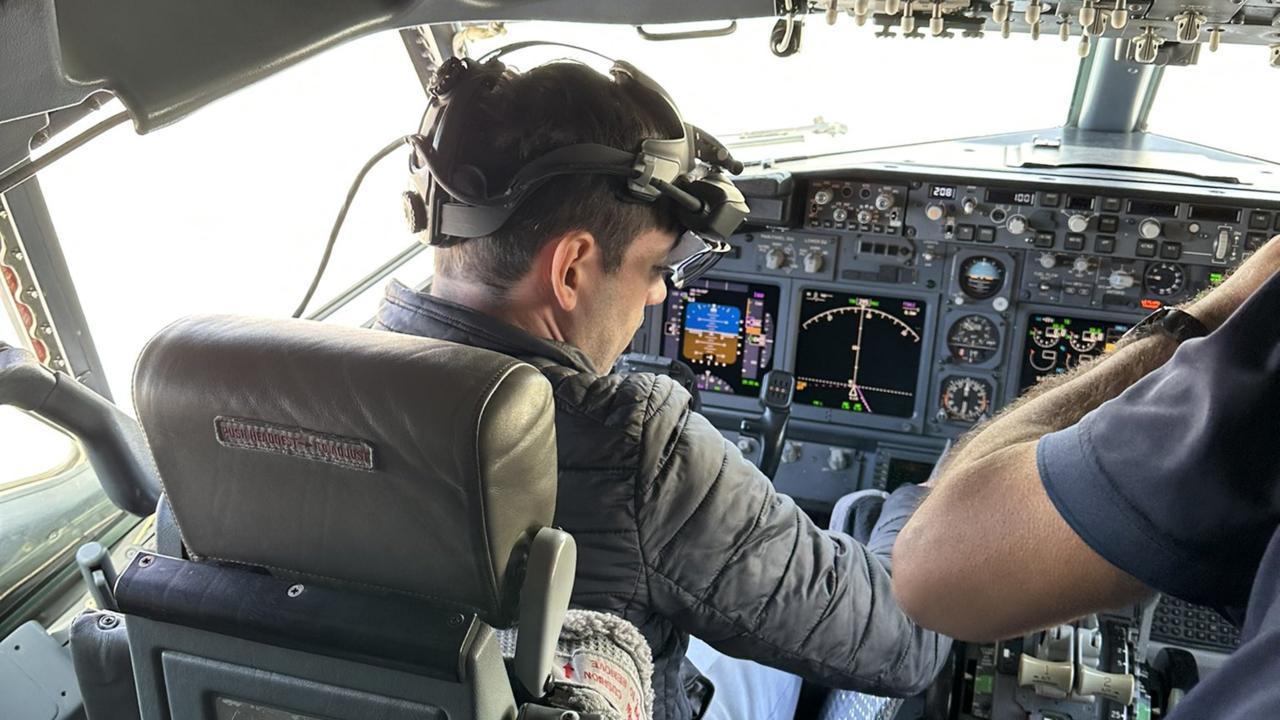
Post by : Amit
Photo : X / Patrick Roa
Augmented Reality Takes Off in Commercial Aviation
Canadian startup Aeroaware has officially introduced the world’s first fully certified augmented reality (AR) solution for commercial and business aircraft. The system, which projects real-time flight data and critical visual cues directly into the pilot’s field of vision, is being heralded as a game-changer for cockpit safety, situational awareness, and flight efficiency.
The aviation sector has long sought tools that could bridge the gap between digital data and physical awareness—especially in challenging flying conditions such as poor visibility, complex terrain, or high-traffic airspaces. With this launch, Aeroaware has turned that ambition into an operational reality. Integrated into Universal Avionics’ InSight Display System, this AR platform sets a new benchmark in how pilots perceive and interact with their flight environment.
FAA and EASA Certification: A Landmark in Aviation Safety
Aeroaware’s AR solution has achieved what no other civil aviation AR system has before—certification from both the Federal Aviation Administration (FAA) under Technical Standard Orders (TSO) and recognition under European Union Aviation Safety Agency (EASA) regulations. These rigorous certifications validate that the technology meets stringent global aviation safety standards and is ready for real-world deployment.
What makes this milestone especially significant is its application in commercial settings. While military aircraft have used augmented reality for years, translating similar technology for civilian use—with full regulatory backing—represents a giant leap forward. Aeroaware CEO Dave Hume emphasized, “We’re not just adding technology for the sake of novelty. We’re embedding critical context into every flying decision, exactly when it’s needed most.”
Transforming the Pilot’s View with Layered Intelligence
The core of Aeroaware’s system lies in its intelligent Head-Up Display (HUD) interface, which superimposes a wide array of situational data—including synthetic vision, terrain topology, runway geometry, and live airport overlays—into a unified, 3D augmented view. This real-time information fusion empowers pilots to anticipate and react faster, especially during low-visibility approaches, night flights, or when navigating through dense or unfamiliar airspace.
Unlike traditional flight displays that require scanning multiple panels and interpreting abstract symbols, Aeroaware's AR interface offers an immersive, intuitive visual experience. It doesn’t replace existing instruments but supplements them with enhanced depth, spatial alignment, and predictive cues. During trials, pilots reported smoother landings, sharper response times, and reduced stress levels.
Flight-Tested Across Multiple Aircraft Platforms
Before it earned regulatory green lights, Aeroaware’s AR system underwent years of testing aboard various aircraft types, from regional jets to long-haul widebodies. Engineers worked meticulously to ensure that the augmented overlays didn’t create visual noise or distract from core flight operations. Instead, the system prioritizes relevant information—such as elevation contours, waypoints, and potential obstructions—while filtering out non-essential data.
The software’s ability to adapt in real time, even during turbulence or aggressive maneuvers, gives it a functional edge. According to Aeroaware’s flight engineers, this dynamic stability is one of the platform’s defining features, ensuring that pilots maintain uninterrupted spatial awareness under all conditions.
Ideal for Retrofits and Fleet Modernization
One of the system’s biggest advantages lies in its compatibility with retrofit applications. Instead of requiring a complete avionics overhaul, airlines can integrate Aeroaware’s solution into their existing Universal Avionics cockpit displays. This approach drastically reduces installation downtime and cost, opening the door for widespread adoption across budget-sensitive operators.
Dror Yahav, President of Universal Avionics, stated, “This is a cost-effective leap into the future. With Aeroaware’s platform, we’re giving operators access to next-generation cockpit tools without the burden of full system replacements or extended grounding.”
The system’s modular architecture also makes it ideal for mixed fleets, from short-haul regional aircraft to large business jets. As regulators increasingly emphasize modernization and automation, such scalable AR tools could become a baseline expectation.
Merging Physical Reality with Synthetic Vision
Aeroaware’s greatest breakthrough may be its seamless integration of synthetic vision, real-world terrain mapping, and live sensor data—all overlaid in real-time through an AR lens. For pilots, this represents a paradigm shift from reactive flying to proactive navigation. Whether guiding a descent onto a fogged-in runway or identifying taxiway paths in an unfamiliar airport, the system provides a digitally enhanced map directly in the pilot’s natural field of view.
The system doesn’t simply display more data—it displays the right data, at the right time, in the right place. With the aviation industry under increasing pressure to reduce human error and improve operational efficiency, such innovations aren’t just enhancements—they’re essential.
Built for the Future: Modular, Upgradable, Scalable
Aeroaware didn’t stop at flight certification. Its AR platform is built on an open-architecture framework designed for ongoing upgrades and modular expansion. Planned features in development include integrated weather overlays, taxiway guidance systems, real-time traffic visuals, and even training tools for pilot simulations.
Already, the company is in discussion with MROs, OEMs, defense agencies, and urban air mobility (UAM) developers to adapt the technology for wider applications. Rotorcraft and next-gen eVTOL aircraft are particularly high-interest targets, where situational awareness and fast decision-making are paramount due to dense urban flight paths and limited automation maturity.
A New Standard in Human-Machine Collaboration
As aviation transitions into an era of higher automation and increasing airspace congestion, the role of human-machine interfaces is coming under renewed focus. Aeroaware’s AR system embodies this evolution—moving beyond traditional screens and knobs to offer pilots a deeply immersive, heads-up experience where vital decisions are guided by natural, spatially relevant cues.
Experts see this development as part of a broader movement toward “intelligent cockpits,” where advanced software supports human decision-making without overwhelming the user. “This isn’t about replacing pilots—it’s about amplifying their instincts,” said an FAA safety advisor who reviewed Aeroaware’s certification process.
Real-World Benefits and Operator Feedback
The benefits go beyond flashy tech. Early users report significant real-world impact. In preliminary feedback, pilots noted faster approach stabilization, clearer situational comprehension, and even reduced fatigue on long-haul flights. One test pilot described it as “flying with x-ray vision,” saying, “It’s like having a second brain helping you parse the outside world without ever taking your eyes off the path ahead.”
This improvement in cognitive workload management is particularly relevant as aviation faces a shortage of experienced pilots and increasing demand for more flights in more complex airspaces. Systems that help streamline pilot duties could prove vital in maintaining global aviation safety standards.
Market Rollout and Strategic Goals
With the first wave of certifications secured, Aeroaware aims to begin deliveries in Q4 2025. The initial rollout will target regional North American carriers, business jet owners, and select European operators. Simultaneously, Aeroaware is working with aviation training organizations to offer AR-based simulator experiences, allowing pilots to become familiar with the technology before entering active service.
Looking ahead, the company’s five-year strategy includes deeper engagement with helicopter manufacturers, advanced air mobility startups, and military partners. Aeroaware’s leadership believes that within a decade, AR cockpit systems will no longer be seen as optional add-ons but as foundational tools for every modern aircraft.
Safety, Innovation, and the Human Factor
Aeroaware’s launch comes at a pivotal moment for the aviation industry, where digital transformation is reshaping every aspect of flight operations. From carbon-neutral goals to smart avionics, the skies of the future will be defined not just by what planes can do, but by how pilots interact with them.
By putting intuitive, real-time AR visuals at the center of the cockpit experience, Aeroaware has opened the door to a safer, smarter, more responsive aviation era. As Hume aptly puts it, “We’re not just building tech—we’re giving pilots superpowers.”
In an industry that typically moves cautiously when adopting new cockpit technologies, Aeroaware’s success story shows what’s possible when innovation meets safety, and imagination meets regulation. The company’s achievement doesn’t just raise the bar—it redefines it.
Aeroaware, Augmented Reality System, Aviation










Bengaluru-Mumbai Superfast Train Approved After 30-Year Wait
Railways approves new superfast train connecting Bengaluru and Mumbai, ending a 30-year demand, easi

Canada Post Workers Strike Halts Nationwide Mail and Parcel Services
Canada Post halts operations as CUPW strike disrupts mail and parcel delivery nationwide amid disput

PM Modi Launches BSNL ‘Swadeshi’ 4G Network, 97,500 Towers Built
India enters global telecom league as PM Modi inaugurates BSNL’s indigenous 4G, connecting 26,700 vi

India’s Iconic MiG‑21 Takes Final Flight After Six Decades of Service
After 60 years India retires its MiG‑21 fighter jet, a legendary yet controversial warplane marking

Hindustan Zinc unveils AI hotspot monitoring at Debari smelter
Hindustan Zinc launches AI-powered Switchyard Hotspot Monitoring at Debari smelter to cut outages bo

Chinese experts worked inside sanctioned Russian drone plant
Chinese drone specialists visited IEMZ Kupol supplying parts and drones via intermediaries, deepenin